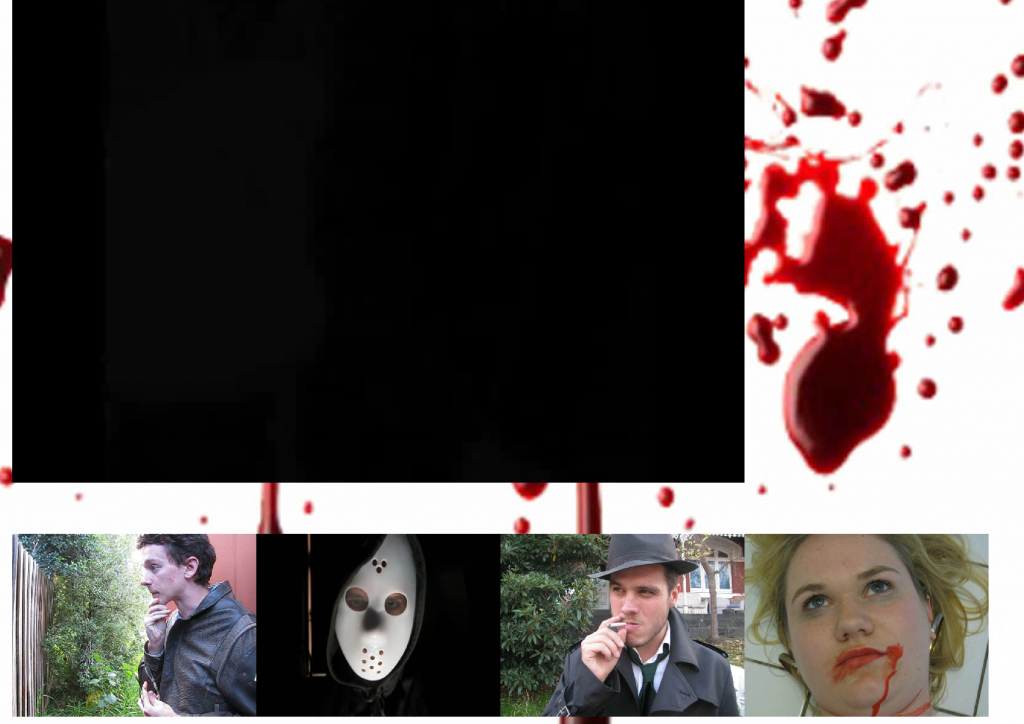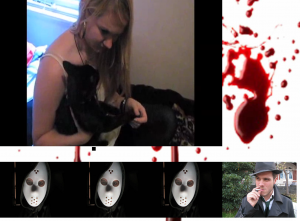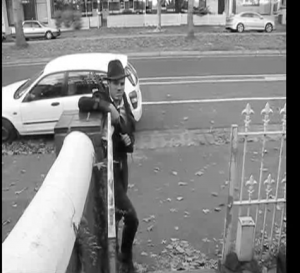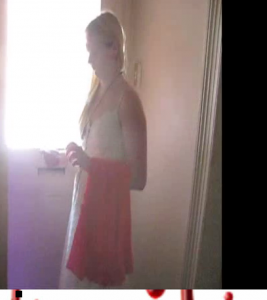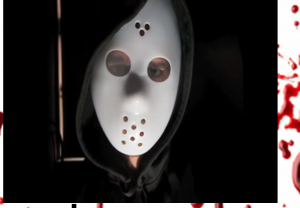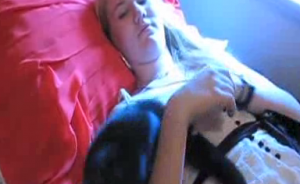Integrated Media Assessment task 2 – Film Essay
The film I have chosen to study is called “Murder!” by John Roebuck, Katherine Buzza, Laurence Cummings and Lincoln MacKinnon. It tells the story of a young woman murdered by a man in a mask, of the detective who is trying to solve the case and of the witness who saw the whole thing. The film is fragmented and told out of order so that only pieces of information are presented at any given time and the full story can only be understood by traveling through the whole film.
Interface: Interface plays a very important role in the way this narrative has been communicated. The film is set up so that at any given point there is the primary screen which contains the video being viewed and 4 smaller thumbnails beneath it, as can be seen in figure 1.
Rather than being a preview of the next video that can be chosen, these thumbnails will be one of four still images, each one representing one of the four characters in the narrative. Thus, the viewer knows that by clicking on a certain image, the next video that will be shown will be a new addition to the story of that certain character which is displayed in the thumbnail. However, as can be seen in figures 2 and 3, it not always all four options being presented to the viewer but can sometimes be a few of the same character’s thumbnail or even all four belonging to the one character.
This may be because too many clips belonging to the other characters had been viewed previously and not enough of that character or that the creators felt that the next clips of the story of that character were the best to follow whichever clip had just been seen. This highly structured interface is made very easy to comprehend so the audience can understand how they will be progressing through the narrative.
Content: The content acts as the tie between the interface and the pattern of the film. The distinctive interface gives the viewers some idea about what the content will be of the next clip they will see because they know which character it will feature. However, it is the established pattern of the four different characters and different clips that also informs the viewers of the content because they have come to understand how this film has been structured. The content of the film itself contains the hours before, during and after the murder takes place and showcases the four people involved in the crime; the culprit, the victim, the detective and the witness. The viewer sees the crime from all four points of view and thus gains a much broader understanding of the crime itself. However, the fracturing of the content by delivering it out of sequence and using the different viewpoints causes the viewer to be more intrigued by the story and eager to see more of the content. The difference between this film and some other Korsakow films is that this one presents a distinguishable narrative. Its content includes clear characters, action, cause and effect and temporal structure, all elements which Bordwell and Thompson claim to be necessary for a narrative (Bordwell and Thompson, p. 79). While many of the other Korsakow films I have seen use a collection of seemingly random clips which may form a narrative due to pattern and order, this film uses the story itself to create the Korsakow films, fracturing the story into different segments, creating an entirely new element to the classic murder mystery narrative.
Pattern: “Murder!” uses a series of patterns to further enhance the delivery of the narrative. While there is the obvious pattern of every clip being clearly linked to the overall causal narrative being told, there are various other patterns within the film. Similar to the interface, another pattern is the use of the four different characters to tell the story. Once they have begun moving through the film, the viewer can see the pattern being used, that by selecting a thumbnail with the image of a certain character the next clip they will see will contain the next part of that character’s story. But beyond that, there are more patterns which can be explored. Each character has it’s own style which is distinguished by the inclusion and repetition of certain elements to form pattern which is only present in the clips belonging to that character. For example, every clip belonging to the detective is in black and white, as can be seen in figure 4.
Each clip with the murderer has parts of one song playing in the background and almost every clip of the victim has one line from another song repeating through it. The patterns of sound through the clips play an important element in the film. The similar sounds of the culprit and the victim make the clips of those characters seem a lot more connected than the other two. Meanwhile, the clips of the witness bear almost no sound whatsoever. This separates him from the rest of the characters but also emphasises his role as a voyeur in both the film and the crime, watching but taking little action. He is not the focus of his own scenes, the victim is. The viewer, along with the witness, watches the victim silently through a variety of windows and doors. The pattern of silence in the witness’s clips is juxtaposed against the sound in the detective clips as the detective is the only character of the four who has natural sound and differentiates between the detective and the rest of the characters, making him the only one to seem real.
A pattern of lighting also emerges which is used to differentiate the murderer and the victim. Many of the murderer’s clips are very dark or have strong shadows, as can be seen in figure 5. This is juxtaposed against clips of the victim who often has bright light or just generally lighter surroundings, as is seen in figure 6.
This pattern contrasts the light and dark of these two characters until they eventually merge. Once we begin to see the victim in the murderer’s clips and vice versa, the lighting and shadows disappear to more of a neutral light setting as the opposites have come together. Thus, the pattern foreshadows the meeting of these two opposing characters. A similar use of emerging pattern to foreshadow is the inclusion of an item featuring the colour red in the majority of the victim’s clips, as can be seen in figure 7, which are later represented as her blood.
Connections: All three elements are put together to make a very interesting film. The makers appear to have used Korsakow itself as a style and means of telling this story. The simple interface of the four thumbnail options allow the viewer to move easily through the story and allows the patterns to emerge. The fragmented and interactive way that korsakow presents it’s content allows the viewer to be submerged in the story, almost as if they too are the detective and are solving the crime by discovering different clues and elements of the story at different moments. However, the downfall of having such a strong and obviously set and presented narrative within korsakow restricts the program and its signature structure from being able to deliver a truly unique experience to each viewer as a regular, disjointed film would. This is due to the strength of the temporal timeline of the film. Even though the events are viewed out of order and from different perspectives, the viewer still knows where each clip fits within the timeline and so forms one story in their mind and any other viewer is likely to create this same story. This weakens the effect of using Korsakow because each story experience is not as unique to the viewer as it could be.
References:
Bordwell, D, Thompson, K 2013, Film Art: An Introduction, 10th edn, McGraw-Hill, New York
Buzza, K, Cummings, L, MacKinnon, L and Roebuck, J 2011, Murder!, Korsakow film, viewed on 3/4/2014, http://vogmae.net.au/classworks/2011/Murder.html
